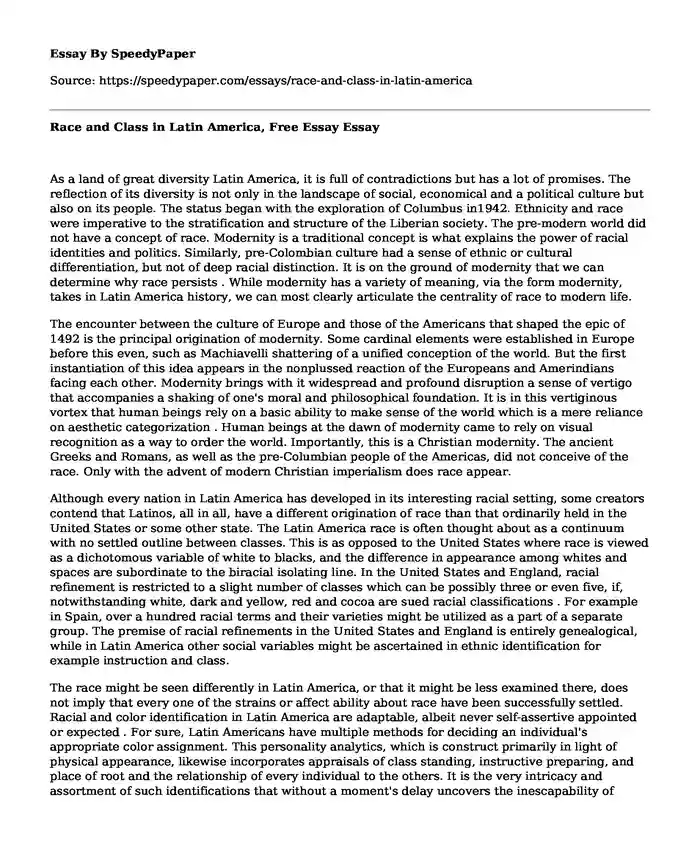As a land of great diversity Latin America, it is full of contradictions but has a lot of promises. The reflection of its diversity is not only in the landscape of social, economical and a political culture but also on its people. The status began with the exploration of Columbus in1942. Ethnicity and race were imperative to the stratification and structure of the Liberian society. The pre-modern world did not have a concept of race. Modernity is a traditional concept is what explains the power of racial identities and politics. Similarly, pre-Colombian culture had a sense of ethnic or cultural differentiation, but not of deep racial distinction. It is on the ground of modernity that we can determine why race persists . While modernity has a variety of meaning, via the form modernity, takes in Latin America history, we can most clearly articulate the centrality of race to modern life.
The encounter between the culture of Europe and those of the Americans that shaped the epic of 1492 is the principal origination of modernity. Some cardinal elements were established in Europe before this even, such as Machiavelli shattering of a unified conception of the world. But the first instantiation of this idea appears in the nonplussed reaction of the Europeans and Amerindians facing each other. Modernity brings with it widespread and profound disruption a sense of vertigo that accompanies a shaking of one's moral and philosophical foundation. It is in this vertiginous vortex that human beings rely on a basic ability to make sense of the world which is a mere reliance on aesthetic categorization . Human beings at the dawn of modernity came to rely on visual recognition as a way to order the world. Importantly, this is a Christian modernity. The ancient Greeks and Romans, as well as the pre-Columbian people of the Americas, did not conceive of the race. Only with the advent of modern Christian imperialism does race appear.
Although every nation in Latin America has developed in its interesting racial setting, some creators contend that Latinos, all in all, have a different origination of race than that ordinarily held in the United States or some other state. The Latin America race is often thought about as a continuum with no settled outline between classes. This is as opposed to the United States where race is viewed as a dichotomous variable of white to blacks, and the difference in appearance among whites and spaces are subordinate to the biracial isolating line. In the United States and England, racial refinement is restricted to a slight number of classes which can be possibly three or even five, if, notwithstanding white, dark and yellow, red and cocoa are sued racial classifications . For example in Spain, over a hundred racial terms and their varieties might be utilized as a part of a separate group. The premise of racial refinements in the United States and England is entirely genealogical, while in Latin America other social variables might be ascertained in ethnic identification for example instruction and class.
The race might be seen differently in Latin America, or that it might be less examined there, does not imply that every one of the strains or affect ability about race have been successfully settled. Racial and color identification in Latin America are adaptable, albeit never self-assertive appointed or expected . For sure, Latin Americans have multiple methods for deciding an individual's appropriate color assignment. This personality analytics, which is construct primarily in light of physical appearance, likewise incorporates appraisals of class standing, instructive preparing, and place of root and the relationship of every individual to the others. It is the very intricacy and assortment of such identifications that without a moment's delay uncovers the inescapability of racial speculation and it's mooted, however capable, nearness in political and monetary life and history.
What is important about this is that through Latin America, there is considerable racial mixing and understandings of race are different than those of other states. However, the extensive race mixing does not challenge white supremacy in these countries of the racial hierarchy where racial minorities are comparatively disadvantaged from those designated as whites or those that are lighter skinned. Taken overall, this wide scope of studies on ethnohistory ecological and lawful issues, training and culture propel our comprehension of race and ethnicity in Latin America . In the process, these reviews consolidate related issues of how chronicled and political advancements in Latin America have and keep on being, experienced differently given shifting gendered and class perspective.
For some Americans, the expression "blended race" infers a biracial affair of having one parent dark and another white, or maybe one white and the other Asian. However, for some U.S. Latinos, blended race character goes up against a different importance – one that is attached to Latin America's pioneer history and regularly incorporates having a white and indigenous foundation some place in their family line.
Bibliography
Dominguez, Jorge I. Race and Ethnicity in Latin America. New York: Garland Pub, 1994.
Gregory, Steven, and Roger Sanjek. Race. New Brunswick, N.J.: Rutgers University Press, 1994.
Cite this page
Race and Class in Latin America, Free Essay. (2018, Jan 17). Retrieved from https://speedypaper.net/essays/race-and-class-in-latin-america
Request Removal
If you are the original author of this essay and no longer wish to have it published on the SpeedyPaper website, please click below to request its removal:
- Free Essay on Protecting Personal Information (PPI)
- A Concept Analysis of Spiritual Nursing Care - Free Essay in Nursing
- Education Essay Sample: Alternative Observation of Teaching Approaches
- HRM Essay Example on Employee Remuneration
- Free sample: Pneumonia Nursing Care Plan
- The African-American Culture and Medicine - Essay Sample
- Free Essay: Description of Moral and Ethical Issues
Popular categories





